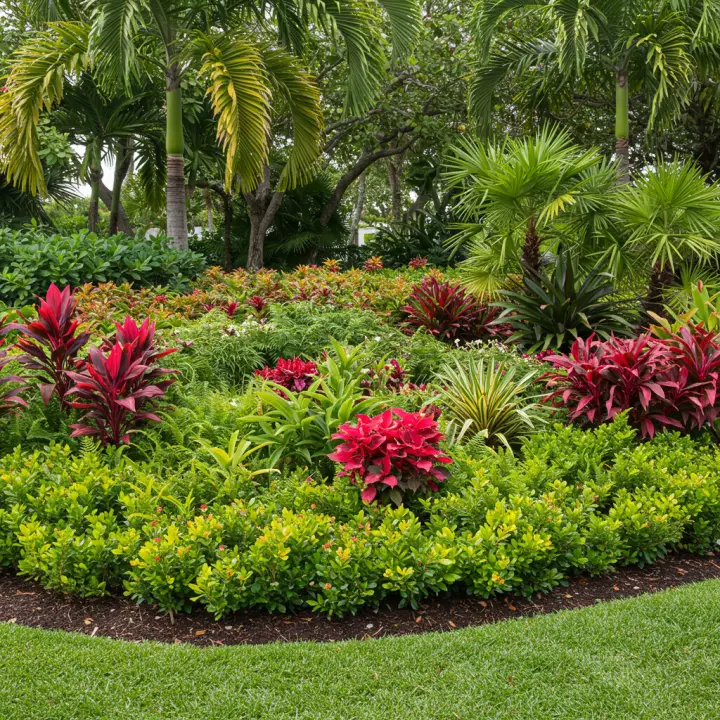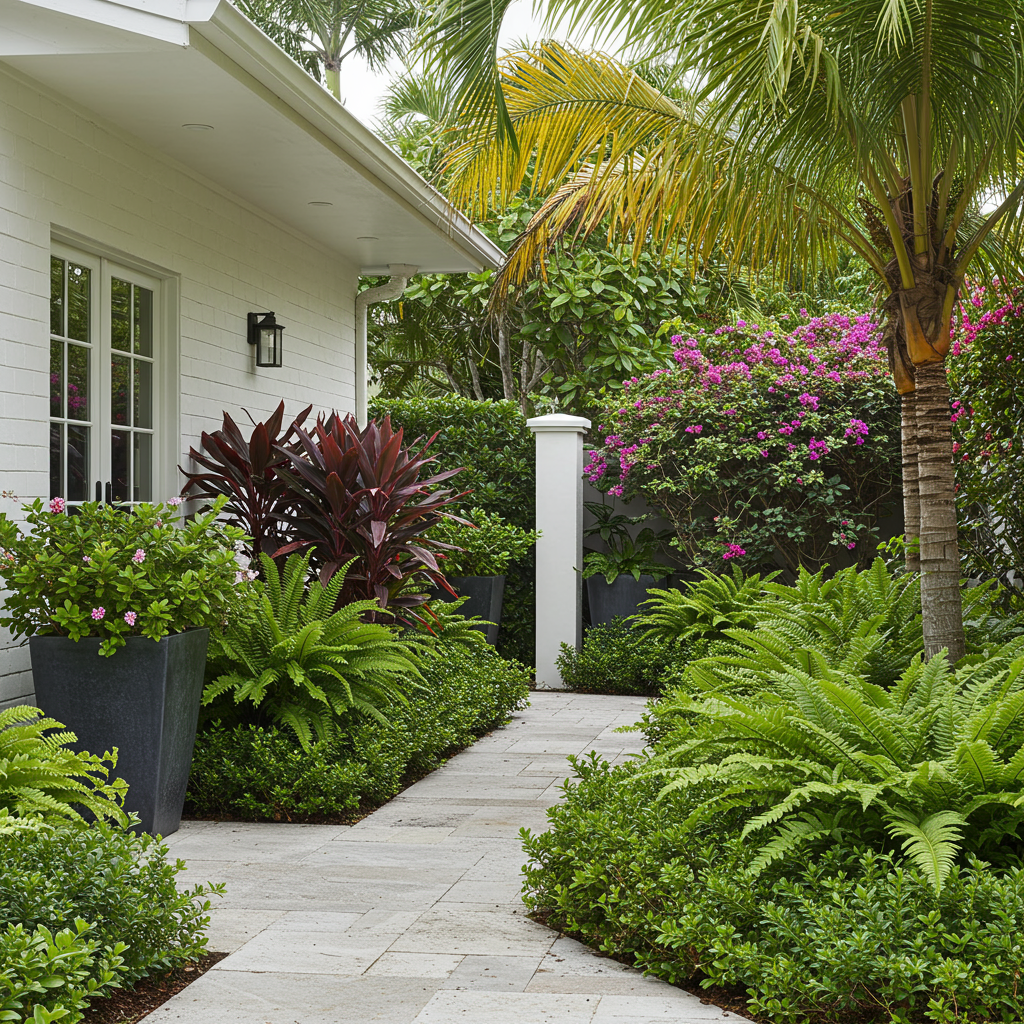Discover the ultimate guide to selecting the best South Florida Landscaping Plants for a thriving, beautiful, and resilient garden. From stunning trees and versatile shrubs to vibrant flowers and groundcovers, we cover drought-tolerant, salt-tolerant, and low-maintenance options perfect for the unique South Florida climate.
South Florida, with its unique blend of sunshine, humidity, and occasional hurricanes, presents both opportunities and challenges for landscapers and home gardeners. Creating a truly stunning and sustainable outdoor space requires careful selection of plants that can not only survive but thrive in this tropical environment. Whether you’re a seasoned gardener or just starting, choosing the right South Florida landscaping plants is the key to a vibrant, low-maintenance, and eye-catching yard.

Why Choose the Right South Florida Landscaping Plants?
The subtropical climate of South Florida is distinct. We experience hot, wet summers, mild, dry winters, sandy soils, and potential threats like strong winds and salt spray near the coast. Generic garden plants often fail to thrive here, leading to wasted effort and resources. By focusing on plants uniquely suited to our region, you ensure:
Longevity and Vigor: Plants adapted to the climate will grow stronger and live longer.
Water Conservation: Many local favorites are drought-tolerant, reducing your water bill.
Pest and Disease Resistance: Native and well-adapted plants often have natural defenses.
Hurricane Resilience: Stronger root systems and flexible branches can withstand high winds better.
Ecological Benefits: Native plants support local wildlife, including pollinators and birds.
Essential Considerations for Your South Florida Landscape
Before you buy your first plant, consider these critical factors to make informed choices.
Drought Tolerance
Water conservation is crucial. Many excellent South Florida plants are highly drought-tolerant once established, meaning they require minimal supplemental watering. This saves time, money, and is environmentally responsible.
Salt Tolerance
If your property is near the coast, salt spray is a significant factor. Opt for plants known to tolerate high levels of salt in both the air and soil to prevent damage and ensure healthy growth.
Sun Exposure Preferences
Observe your yard throughout the day. Does an area receive full sun (6+ hours), partial sun (3-6 hours), or shade (less than 3 hours)? Matching plants to their preferred light conditions is vital for their health.
Maintenance Levels
Do you dream of a meticulous garden or a low-upkeep oasis? South Florida landscaping offers options for both. Many locals prefer low-maintenance selections that require less pruning, fertilizing, and pest control.
Native vs. Non-Native Plants
Florida natives are perfectly adapted to the climate and soil, supporting local ecosystems. However, many non-native, well-adapted exotic plants also flourish here and add to the tropical aesthetic, as long as they are not invasive.
—
Top Must-Have South Florida Landscaping Plants: Our Picks!
Ready to bring your garden vision to life? Here are some of our top picks for must-have South Florida landscaping plants, categorized for easy planning.
Stunning Trees for Shade & Beauty
Trees provide structure, shade, and can become the focal point of your landscape.
Live Oak (Quercus virginiana): A majestic, long-lived native tree offering extensive shade and hurricane resistance. Its sprawling canopy is iconic.
Gumbo Limbo (Bursera simaruba): Often called the “Tourist Tree” for its peeling red bark, this native is fast-growing, salt-tolerant, and exceptionally hardy.
Royal Palm (Roystonea regia): Tall, stately, and a symbol of South Florida. Its smooth, gray trunk and grand crown make it a magnificent specimen tree.
Mahogany (Swietenia mahagoni): A beautiful native shade tree with high wind resistance and attractive foliage.
Frangipani (Plumeria rubra): Famous for its wonderfully fragrant, colorful flowers, perfect for adding a tropical scent and feel near patios.
Versatile Shrubs for Structure & Color
Shrubs offer privacy, define spaces, and add layers of texture and color.
Dwarf Ixora (Ixora coccinea ‘Nora Grant’): A go-to for vibrant, continuous color with clusters of bright red, pink, or orange flowers. Excellent for hedges or accents.
Firebush (Hamelia patens): This native shrub is a hummingbird and butterfly magnet, producing small, tubular red-orange flowers almost year-round. It’s also very drought-tolerant.
Podocarpus (Podocarpus macrophyllus): An excellent choice for a dense, evergreen hedge or screen. It’s adaptable to various light conditions and can be pruned formally or informally.
Coontie (Zamia integrifolia): A slow-growing, highly durable native cycad that resembles a small fern. It’s extremely drought-tolerant and a larval host for the Atala butterfly.
Buttonwood (Conocarpus erectus): A remarkably tough native, especially for coastal properties. It handles salt spray, thrives in full sun, and can be grown as a shrub or small tree.
Vibrant Flowers & Groundcovers for Pop of Color
Add splashes of continuous color and cover bare ground with these choices.
Pentas (Pentas lanceolata): Known as Egyptian Starcluster, Pentas produces clusters of star-shaped flowers that are irresistible to butterflies and hummingbirds. Comes in shades of pink, red, purple, and white.
Lantana (Lantana camara): A tough, drought-tolerant perennial with colorful flower clusters. Many varieties are sterile or low-seed producing, making them a good, non-invasive choice. Attracts butterflies.
Mondo Grass (Ophiopogon japonicus): A popular evergreen groundcover that forms dense tufts of dark green, grass-like foliage. It’s low-growing and low-maintenance, perfect for shaded areas or borders.
Dwarf Oyster Plant (Tradescantia spathacea ‘Tricolor’): Offers striking purple and green variegated foliage, excellent for adding a pop of color as a groundcover, in rock gardens, or borders.
Beach Sunflower (Helianthus debilis): A fast-growing native groundcover that produces cheerful yellow daisy-like flowers. Exceptionally salt and drought-tolerant, it’s perfect for sunny, sandy areas.
Designing Your Dream South Florida Landscape
Selecting individual plants is just the beginning. Consider grouping plants with similar water, light, and soil needs. Think about layering – taller plants in the back, shorter ones in the front – to create depth. Don’t forget hardscaping elements like pathways, patios, and outdoor lighting to complement your plant choices. If the task feels too big, consider consulting a local landscape designer familiar with South Florida landscaping plants.
Frequently Asked Questions (FAQs) About South Florida Landscaping Plants
Q1: What makes a plant “drought-tolerant” in South Florida?
A1: Drought-tolerant plants have evolved mechanisms to survive periods of low water. They might have waxy leaves, deep root systems, or store water, making them resilient to South Florida’s dry seasons once established.
Q2: Are native plants always better for a South Florida landscape?
A2: While native plants offer significant ecological benefits and are naturally adapted to the climate, many non-native, well-adapted plants also thrive here. The key is to avoid invasive species and choose non-natives that complement your local ecosystem without harming it.
Q3: How often should I water new plants in South Florida?
A3: New plantings require consistent watering to establish their root systems. Water deeply every day or two for the first few weeks, gradually reducing frequency to encourage roots to seek out water. Always check soil moisture before watering.
Q4: What about dealing with pests and diseases in South Florida?
A4: Healthy trees and plants are more resistant to pests and diseases. Choose adapted species, provide proper care, and practice good sanitation. If issues arise, identify the problem correctly before applying targeted, environmentally friendly solutions.
Q5: Can I create a truly low-maintenance landscape in South Florida?
A5: Absolutely! By selecting drought-tolerant, disease-resistant, and slow-growing South Florida landscaping plants, and designing with efficiency in mind, you can significantly reduce the amount of time and effort required to maintain a beautiful yard.
Conclusion
Creating a beautiful and sustainable landscape in South Florida is a rewarding endeavor. By carefully choosing South Florida landscaping plants that are perfectly suited to the local climate, you can cultivate a thriving oasis that provides beauty, shade, and ecological benefits for years to come. Embrace native selections, consider the unique challenges of our region, and enjoy the vibrant, tropical paradise your garden becomes. Happy planting!

